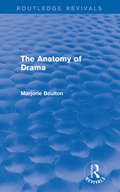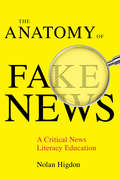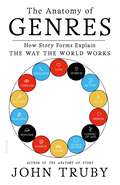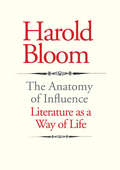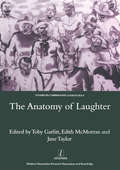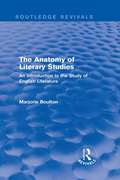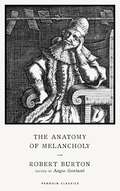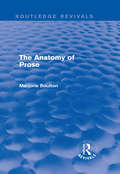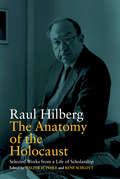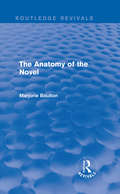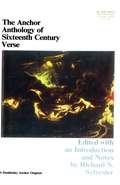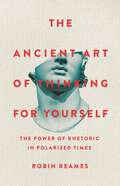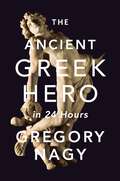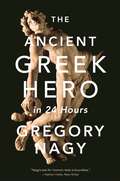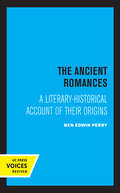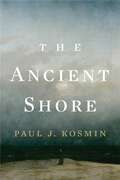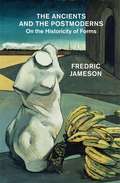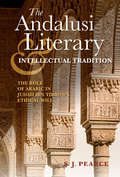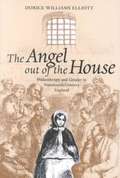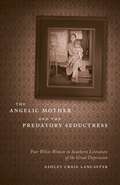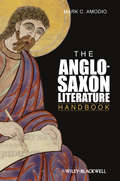- Table View
- List View
The Anatomy of Drama (Routledge Revivals)
by Marjorie BoultonThis title, first published in 1960, is intended primarily to increase the understanding of drama among those who do not have easy access to the live theatre and who, therefore, study plays mainly in print. The author’s emphasis is on Shakespeare, but most forms of drama receive some attention. A lucid and lively study of the techniques of plot, dialogue and characterization will help the reader to a deeper appreciated of the problems and successes of the dramatist.
The Anatomy of Fake News: A Critical News Literacy Education
by Nolan HigdonSince the 2016 U.S. presidential election, concerns about fake news have fostered calls for government regulation and industry intervention to mitigate the influence of false content. These proposals are hindered by a lack of consensus concerning the definition of fake news or its origins. Media scholar Nolan Higdon contends that expanded access to critical media literacy education, grounded in a comprehensive history of fake news, is a more promising solution to these issues. The Anatomy of Fake News offers the first historical examination of fake news that takes as its goal the effective teaching of critical news literacy in the United States. Higdon employs a critical-historical media ecosystems approach to identify the producers, themes, purposes, and influences of fake news. The findings are then incorporated into an invaluable fake news detection kit. This much-needed resource provides a rich history and a promising set of pedagogical strategies for mitigating the pernicious influence of fake news.
The Anatomy of Genres: How Story Forms Explain the Way the World Works
by John TrubyA guide to understanding the major genres of the story world by the legendary writing teacher and author of The Anatomy of Story, John Truby.Most people think genres are simply categories on Netflix or Amazon that provide a helpful guide to making entertainment choices. Most people are wrong. Genre stories aren’t just a small subset of the films, video games, TV shows, and books that people consume. They are the all-stars of the entertainment world, comprising the vast majority of popular stories worldwide. That’s why businesses—movie studios, production companies, video game studios, and publishing houses—buy and sell them. Writers who want to succeed professionally must write the stories these businesses want to buy. Simply put, the storytelling game is won by mastering the structure of genres.The Anatomy of Genres: How Story Forms Explain the Way the World Works is the legendary writing teacher John Truby’s step-by-step guide to understanding and using the basic building blocks of the story world. He details the three ironclad rules of successful genre writing, and analyzes more than a dozen major genres and the essential plot events, or “beats,” that define each of them. As he shows, the ability to combine these beats in the right way is what separates stories that sell from those that don’t. Truby also reveals how a single story can combine elements of different genres, and how the best writers use this technique to craft unforgettable stories that stand out from the crowd. Just as Truby’s first book, The Anatomy of Story, changed the way writers develop stories, The Anatomy of Genres will enhance their quality and expand the impact they have on the world.
The Anatomy of Influence: Literature as a Way of Life
by Harold Bloom"Literary criticism, as I attempt to practice it," writes Harold Bloom in The Anatomy of Influence, "is in the first place literary, that is to say, personal and passionate." For more than half a century, Bloom has shared his profound knowledge of the written word with students and readers. In this, his most comprehensive and accessible study of influence, Bloom leads us through the labyrinthine paths which link the writers and critics who have informed and inspired him for so many years. The result is "a critical self-portrait," a sustained meditation on a life lived with and through the great works of the Western canon:Why has influence been my lifelong obsessive concern? Why have certain writers found me and not others? What is the end of a literary life? Featuring extended analyses of Bloom's most cherished poets--Shakespeare, Whitman, and Crane--as well as inspired appreciations of Emerson, Tennyson, Browning, Yeats, Ashbery, and others, The Anatomy of Influence adapts Bloom's classic work The Anxiety of Influence to show us what great literature is, how it comes to be, and why it matters. Each chapter maps startling new literary connections that suddenly seem inevitable once Bloom has shown us how to listen and to read. A fierce and intimate appreciation of the art of literature on a scale that the author will not again attempt, The Anatomy of Influence follows the sublime works it studies, inspiring the reader with a sense of something ever more about to be.
The Anatomy of Language: Saying What We Mean (Routledge Library Editions: Semantics and Semiology #2)
by Marjorie BoultonFirst published in 1959, this book aims to provide a practical introduction to semantics, relating the critical study of language to real-life situation, with a wealth of anecdotes and numerous illustrations drawn from everyday personal predicaments. This book provides much information and much material for profitable discussion, helping to make accessible what can be a highly academic subject comprehensible only to a minority. This book provides a highly valuable foundation for students of linguistics and will provide preparation for further study.
The Anatomy of Laughter
by Toby Garfitt"The nature of laughter has recently attracted the attention of a number of different disciplines. In two recent colloquia, TRIO (Translation Research in Oxford) brought together international authorities from fields as diverse as physiology, psychology, linguistics, translation and literary studies, and sociology, with scant regard for political correctness. This fascinating and often hilarious collection of essays is the result. With the contributions: Jane Taylor - Introduction Dominique Bertrand - Anatomie et etymologie: ordre et desordre du rire selon Laurent Joubert Silke Kipper, Dietmar Todt - The Sound of Laughter: Recent Concepts and Findings in Research into Laughter Vocalizations Sarah-Jayne Blakemore - Why Can't You Tickle Yourself? Michael Holland - Belly Laughs Walter Redfern - Upping the Ante/i: Exaggeration in Celine and Valles Giselinde Kuipers - Humour Styles and Class Cultures: Highbrow Humour and Lowbrow Humour in the Netherlands Christie Davies - Searching for Jokes: Language, Translation, and the Cross-Cultural Comparison of Humour Ted Cohen - And What If They Don't Laugh? Iain Galbraith - Without the Rape the Talk-Show Would Not Be Laughable Jean-Michel Deprats - Translating a Great Feast of Languages Paul J. Memmi - Traduire le rire Natacha Thiery - Rire et desir dans les comedies americaines de Lubitsch: l'exemple de Ninotchka (1939) Adam Phillips - What's So Funny? On Being Laughed at ...Sukanta Chaudhuri - Laughing and Talking Georges Roque - Le Rire comme accident en peinture Laurent Bazin - La Couleur du rire: peinture et traduction Gerard Toulouse - Views on the Physics and Metaphysics of Laughter"
The Anatomy of Literary Studies: An Introduction to the Study of English Literature (Routledge Revivals)
by Marjorie BoultonFirst published in 1980, The Anatomy of Literary Studies provides students of English Literature with a clearer understanding of the significance and scope of the subject and a comprehensive background to its study. It gives pointers towards intellectual integrity and advice on independent study, libraries, essay writing and examinations. This reissue of Marjorie Boulton’s classic work will be of particular value to students studying English at university or those applying to a course who would like a fuller understanding of what it might entail.
The Anatomy of Melancholy
by Robert BurtonCelebrating the 400th anniversary of Burton's masterpiece, this fully edited, modern edition is published as a landmark hardback volume in Penguin Classics. Robert Burton's labyrinthine, beguiling, playful masterpiece is his attempt to 'anatomize and cut up' every aspect of the condition of melancholy, from which he had suffered throughout his life. Ranging over beauty, digestion, the planets, alcohol, demons, kissing, poetry and the restorative power of books, among many other things, The Anatomy of Melancholy has fascinated figures from Samuel Johnson to Jorge Luis Borges since the seventeenth century, and remains an incomparable examination of the human condition in all its flawed, endless variety.
The Anatomy of National Fantasy: Hawthorne, Utopia, and Everyday Life
by Lauren Gail BerlantCareful appraisal of The Scarlet Letter.
The Anatomy of Poetry (Routledge Revivals)
by Marjorie BoultonIt is impossible to appreciate poetry fully without some knowledge of the various aspects of poetic technique. First published in 1953, with a second edition in 1982, this title explains all the usual technical terms in an accessible manner. Marjorie Boulton shows that it is possible to approach a poem from a business-like perspective without losing enjoyment. This reissue will be of particular value to students as well as those with a general interest in the specifics of poetry.
The Anatomy of Prose (Routledge Revivals)
by Marjorie BoultonFirst published in 1954, this title is a companion to The Anatomy of Poetry as a literary guide for the student reader. Writing that students generally find it more challenging to analyse a passage of prose than a piece of poetry, Marjorie Boulton takes a systematic approach to the technical elements of prose, considering form, vocabulary, rhythm and the application of historical context. With suggestions for further reading and practical, lucid advice, this reissue will be of particular value to students of English Literature in need of a constructive study aid.
The Anatomy of the Holocaust: Selected Works from a Life of Scholarship (Vermont Studies on Nazi Germany and the Holocaust #8)
by Raul Hilberg Walter H. Pehle René SchlottThough best known as the author of the landmark 1961 work The Destruction of the European Jews, the historian Raul Hilberg produced a variety of archival research, personal essays, and other works over a career that spanned half a century. The Anatomy of the Holocaust collects some of Hilberg’s most essential and groundbreaking writings—many of them published in obscure journals or otherwise inaccessible to nonspecialists—in a single volume. Supplemented with commentary and notes from Hilberg’s longtime German editor and his biographer, it not only offers a multifaceted look at the man and the scholar, but also traces the evolution of Holocaust research from a marginal subdiscipline into a diverse and vital intellectual project.
The Anatomy of the Novel (Routledge Revivals)
by Marjorie BoultonFirst published in 1975, this title provides an introduction to the study of the novel. Marjorie Boulton deals systematically with the major elements of plot, character, authorial conventions, narrative structure, and dialogue and distinguishes different types of fiction. The emphasis is on the mainstream novel, with examples and arguments illustrated by quotations from five classics. Of particular value to students of English Literature, this reissue aims to help the reader ‘not only to read novels more discerningly and to discuss them more profitably, but also to relish the reading more’.
The Anchor Book of Sixteenth Century Verse
by Richard D. SylvesterThis comprehensive anthology contains selections from the work of twenty-five poets of the sixteenth century. Employing the original, rather than normalized, texts, the volume includes complete, non-excerpted poems by John Skelton, Philip Sidney and others. The selections - which include such works as 'The Steele Glass'. Richard S. Sylvester examines the evolution of English poetry through the century, tracing the development of the early Tudor poets through the eloquence of Surrey.
The Ancient Art of Thinking For Yourself: The Power of Rhetoric in Polarized Times
by Robin ReamesHow rhetoric—the art of persuasion—can help us navigate an age of misinformation, conspiracy theories, and political acrimony The discipline of rhetoric was the keystone of Western education for over two thousand years. Only recently has its perceived importance faded. In this book, renowned rhetorical scholar Robin Reames argues that, in today&’s polarized political climate, we should all care deeply about learning rhetoric. Drawing on examples ranging from the destructive ancient Greek demagogue Alcibiades to modern-day conspiracists like Alex Jones, Reames breaks down the major techniques of rhetoric, pulling back the curtain on how politicians, journalists, and &“journalists&” convince us to believe what we believe—and to talk, vote, and act accordingly. Understanding these techniques helps us avoid being manipulated by authority figures who don&’t have our best interests at heart. It also grants us rare insight into the values that shape our own beliefs. Learning rhetoric, Reames argues, doesn&’t teach us what to think but how to think—allowing us to understand our own and others&’ ideological commitments in a completely new way. Thoughtful, nuanced, and leavened with dry humor, The Ancient Art of Thinking for Yourself offers an antidote to our polarized, post-truth world.
The Ancient Greek Hero in 24 Hours
by Gregory NagyThe ancient Greeksâe(tm) concept of âeoethe heroâe#157; was very different from what we understand by the term today, Gregory Nagy arguesâe"and it is only through analyzing their historical contexts that we can truly understand Achilles, Odysseus, Oedipus, and Herakles. In Greek tradition, a hero was a human, male or female, of the remote past, who was endowed with superhuman abilities by virtue of being descended from an immortal god. Despite their mortality, heroes, like the gods, were objects of cult worship. Nagy examines this distinctively religious notion of the hero in its many dimensions, in texts spanning the eighth to fourth centuries bce: the Homeric Iliad and Odyssey; tragedies of Aeschylus, Sophocles, and Euripides; songs of Sappho and Pindar; and dialogues of Plato. All works are presented in English translation, with attention to the subtleties of the original Greek, and are often further illuminated by illustrations taken from Athenian vase paintings. The fifth-century bce historian Herodotus said that to read Homer is to be a civilized person. In twenty-four installments, based on the Harvard University course Nagy has taught and refined since the late 1970s, The Ancient Greek Hero in 24 Hours offers an exploration of civilizationâe(tm)s roots in the Homeric epics and other Classical literature, a lineage that continues to challenge and inspire us today.
The Ancient Greek Hero in 24 Hours
by Gregory NagyThe ancient Greeks’ concept of “the hero” was very different from what we understand by the term today. In 24 installments, based on the Harvard course Nagy has taught and refined since the 1970s, The Ancient Greek Hero in 24 Hours explores civilization’s roots in Classical literature—a lineage that continues to challenge and inspire us.
The Ancient Romances: A Literary-Historical Account of Their Origins (Sather Classical Lectures #37)
by Ben E. PerryThis title is part of UC Press's Voices Revived program, which commemorates University of California Press’s mission to seek out and cultivate the brightest minds and give them voice, reach, and impact. Drawing on a backlist dating to 1893, Voices Revived makes high-quality, peer-reviewed scholarship accessible once again using print-on-demand technology. This title was originally published in 1967.
The Ancient Shore
by Paul J. KosminAn esteemed historian explores the natural and social dynamics of the ancient coastline, demonstrating for the first time its integral place in the world of Mediterranean antiquity.As we learn from The Odyssey and the Argonauts, Greek dramas frequently played out on a watery stage. In particular, antiquity’s key events and exchanges often occurred on coastlines. Yet the shore was not just a site of conquest and trade, ire and yearning. The seacoast was a singular kind of space and was integral to the cosmology of the Greeks and their neighbors. In The Ancient Shore, award-winning historian Paul Kosmin reveals the influence of the coast on the inner lives of the ancients: their political thought, scientific notions, artistic endeavors, and myths; their sense of wonder and of self.The Ancient Shore transports readers to a time when the coast was an unpredictable, formidable site of infinite and humbling possibility. Shorelines served as points of connection and competition that fostered distinctive political identities. It was at the coast—ever violent, ever permeable to predation—that state power ended, and so the coast was fundamental to theories of sovereignty. Then too, the boundary of land and sea symbolized human limitation, making it the subject of elaborate and continuous philosophical, scientific, and religious attention.Kosmin’s ancient world is expansive, connecting the Atlantic to the Straits of Malacca, the Black Sea to the Indian Ocean. And his methods are similarly far-ranging, integrating accounts of statecraft and commerce with intellectual, literary, religious, and environmental history. The Ancient Shore is a radically new encounter with people, places, objects, and ideas we thought we knew.
The Ancients and the Postmoderns
by Fredric JamesonFredric Jameson sweeps from the Renaissance to The Wire High modernism is now as far from us as antiquity was for the Renaissance. Such is the premise of Fredric Jameson's major new work in which modernist works, this time in painting (Rubens) and music (Wagner and Mahler), are pitted against late-modernist ones (in film) as well as a variety of postmodern experiments (from SF to The Wire, from "Eurotrash" in opera to Altman and East German literature): all of which attempt, in their different ways, to invent new forms to grasp a specific social totality. Throughout the historical periods, argues Jameson, the question of narrative persists through its multiple formal changes and metamorphoses.From the Hardcover edition.
The Andalusi Literary and Intellectual Tradition: The Role of Arabic in Judah ibn Tibbon's Ethical Will
by Sarah J. PearceBeginning in 1172, Judah ibn Tibbon, who was called the father of Hebrew translators, wrote a letter to his son that was full of personal and professional guidance. The detailed letter, described as an ethical will, was revised through the years and offered a vivid picture of intellectual life among Andalusi elites exiled in the south of France after 1148. S. J. Pearce sets this letter into broader context and reads it as a document of literary practice and intellectual values. She reveals how ibn Tibbon, as a translator of philosophical and religious texts, explains how his son should make his way in the family business and how to operate, textually, within Arabic literary models even when writing for a non-Arabic audience. While the letter is also full of personal criticism and admonitions, Pearce shows ibn Tibbon making a powerful argument in favor of the continuation of Arabic as a prestige language for Andalusi Jewish readers and writers, even in exile outside of the Islamic world.
The Angel and the Perverts (The Cutting Edge: Lesbian Life and Literature Series #9)
by Lucie Delarue-MardrusSet in the lesbian and gay circles of Paris in the 1920s, The Angel and the Perverts tells the story of a hermaphrodite born to upper class parents in Normandy and ignorant of his/her physical difference. As an adult, s/he lives a double life as Marion/Mario, passing undetected as a lesbian in the literary salons of the times, and as a gay man in the cocaine dens made famous by Colette. Delarue-Mardrus's novel belongs to a category of literature, written between the turn of the century and approximately 1930, which depicted lesbians as members of a third sex. The hermaphrodite became the visual representation of the ways in which lesbians were different from their heterosexual sisters, and Rene Vivien, Natalie Clifford Barney, Rachilde, and Colette, among others, shared Delarue-Mardrus's fascination with the topic.This is the first translation into English of The Angel and the Perverts. In an astute introduction, Anna Livia rereads Lucie Delarue-Mardrus as a prolific and significant writer, despite the fact that previous scholars viewed her primarily as the wife of the scholar and translator Joseph-Charles Mardrus. Livia also places Delarue-Mardrus's life in a lesbian context for the first time and decodes this delightful novel so that readers will feel quite at home in Mario/Marion's unusual world, which runs the gamut from Auguste Rodin to Jean Cocteau and Sarah Bernhardt.
The Angel out of the House: Philanthropy and Gender in Nineteenth-Century England (Victorian Literature and Culture Series)
by Dorice Williams ElliottWas nineteenth-century British philanthropy the "truest and noblest woman's work" and praiseworthy for having raised the nation's moral tone, or was it a dangerous mission likely to cause the defeminization of its practitioners as they became "public persons"? In Victorian England, women's participation in volunteer work seemed to be a natural extension of their domestic role, but like many other assumptions about gender roles, the connection between charitable and domestic work is the result of specific historical factors and cultural representations. Proponents of women as charitable workers encouraged philanthropy as being ideal work for a woman, while opponents feared the practice was destined to lead to overly ambitious and manly behavior.In The Angel out of the House Dorice Williams Elliott examines the ways in which novels and other texts that portrayed women performing charitable acts helped to make the inclusion of philanthropic work in the domestic sphere seem natural and obvious. And although many scholars have dismissed women's volunteer endeavors as merely patriarchal collusion, Elliott argues that the conjunction of novelistic and philanthropic discourse in the works of women writers--among them George Eliot and Elizabeth Gaskell, Hannah More and Anna Jameson--was crucial to the redefinition of gender roles and class relations.In a fascinating study of how literary works contribute to cultural and historical change, Elliott's exploration of philanthropic discourse in nineteenth-century literature demonstrates just how essential that forum was in changing accepted definitions of women and social relations.
The Angelic Mother and the Predatory Seductress: Poor White Women in Southern Literature of the Great Depression (Southern Literary Studies)
by Ashley Craig LancasterIn The Angelic Mother and the Predatory Seductress, Ashley Craig Lancaster examines how converging political and cultural movements helped to create dualistic images of southern poor white female characters in Depression-era literature. While other studies address the familial and labor issues that challenged female literary characters during the 1930s, Lancaster focuses on how the evolving eugenics movement reinforced the dichotomy of altruistic maternal figures and destructive sexual deviants. According to Lancaster, these binary stereotypes became a new analogy for hope and despair in America's future and were well utilized by Depression-era politicians and authors to stabilize the country's economic decline. As a result, the complexity of women's lives was often overlooked in favor of stock characters incapable of individuality. Lancaster studies a variety of works, including those by male authors William Faulkner, Erskine Caldwell, and John Steinbeck, as well as female novelists Mary Heaton Vorse, Myra Page, Grace Lumpkin, and Olive Tilford Dargan. She identifies female stereotypes in classics such as To Kill a Mockingbird and in the work of later writers Dorothy Allison and Rick Bragg, who embrace and share in a poor white background.The Angelic Mother and the Predatory Seductress reveals that these literary stereotypes continue to influence not only society's perception of poor white southern women but also women's perception of themselves.
The Anglo Saxon Literature Handbook
by Mark C. AmodioThe Anglo-Saxon Literature Handbook presents an accessible introduction to the surviving works of prose and poetry produced in Anglo-Saxon England, from AD 410-1066.Makes Anglo-Saxon literature accessible to modern readersHelps readers to overcome the linguistic, aesthetic and cultural barriers to understanding and appreciating Anglo-Saxon verse and proseIntroduces readers to the language, politics, and religion of the Anglo-Saxon literary worldPresents original readings of such works as Beowulf, The Battle of Maldon, The Wanderer, The Seafarer, and The Anglo-Saxon Chronicle
